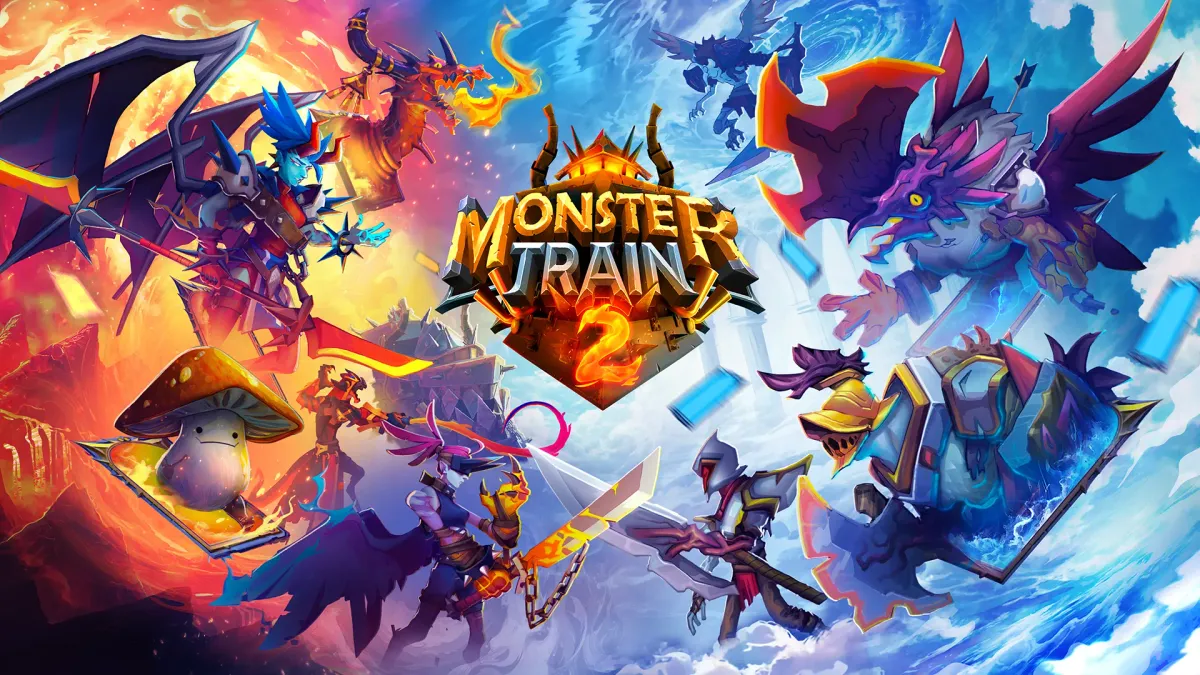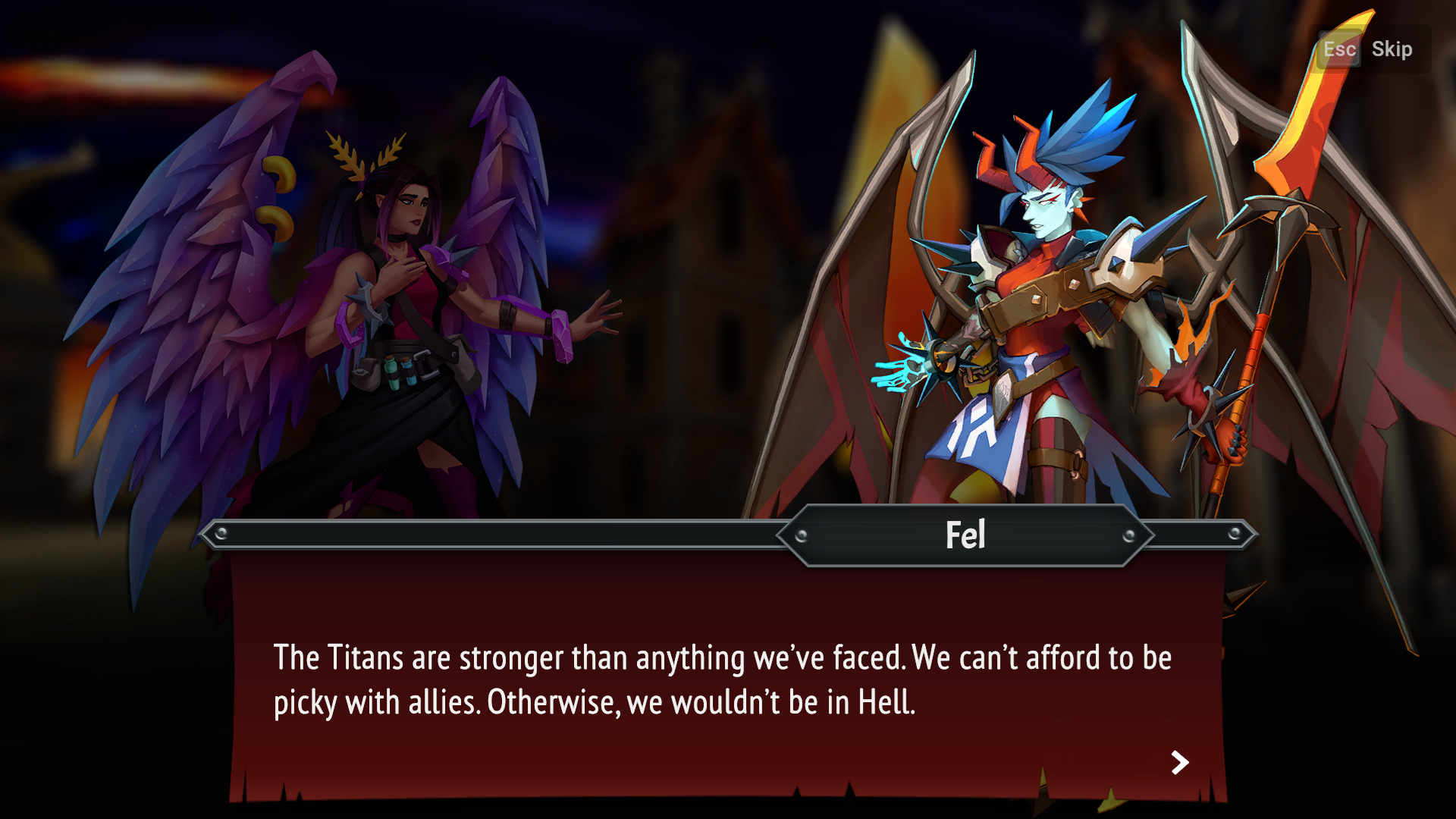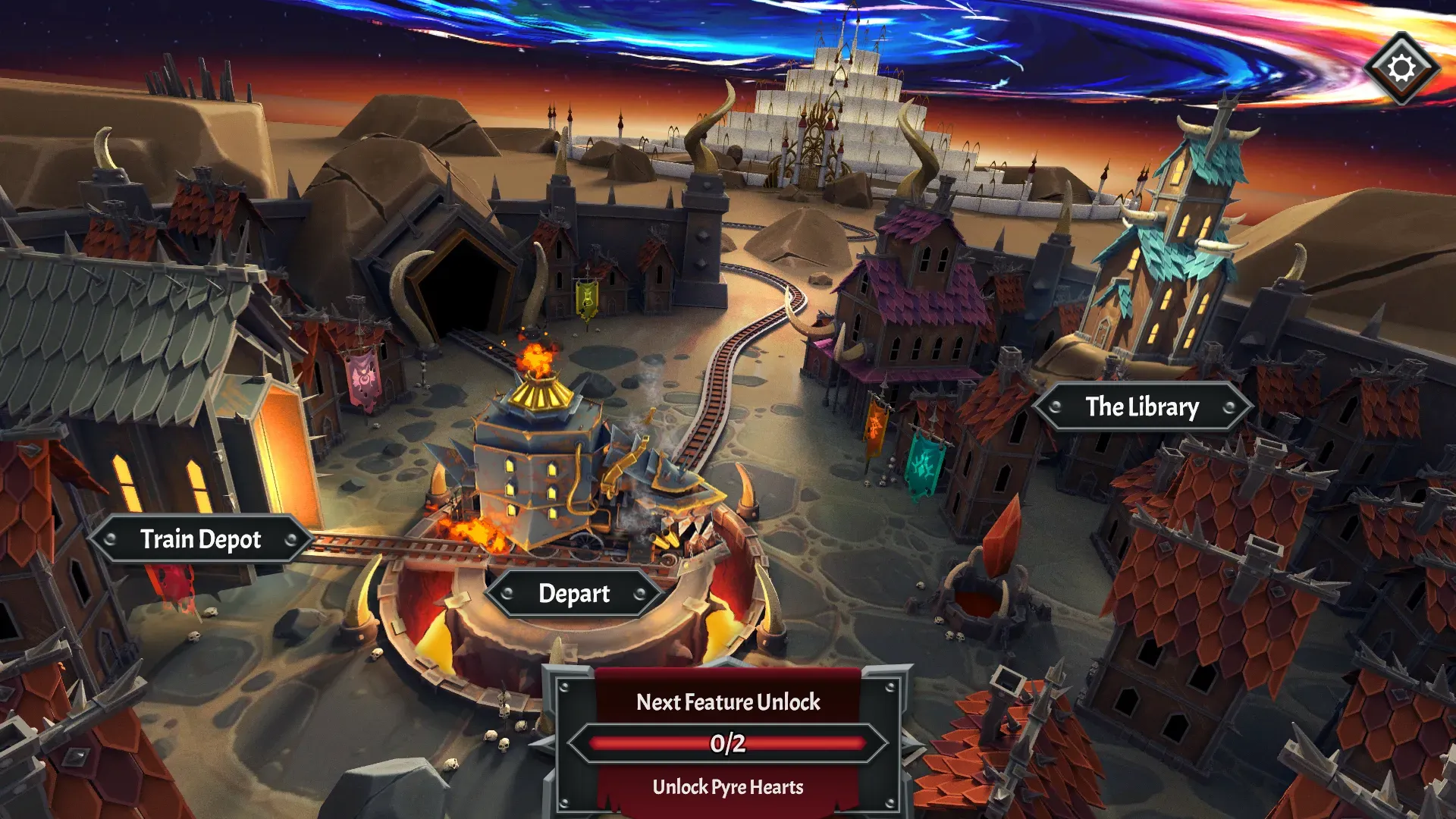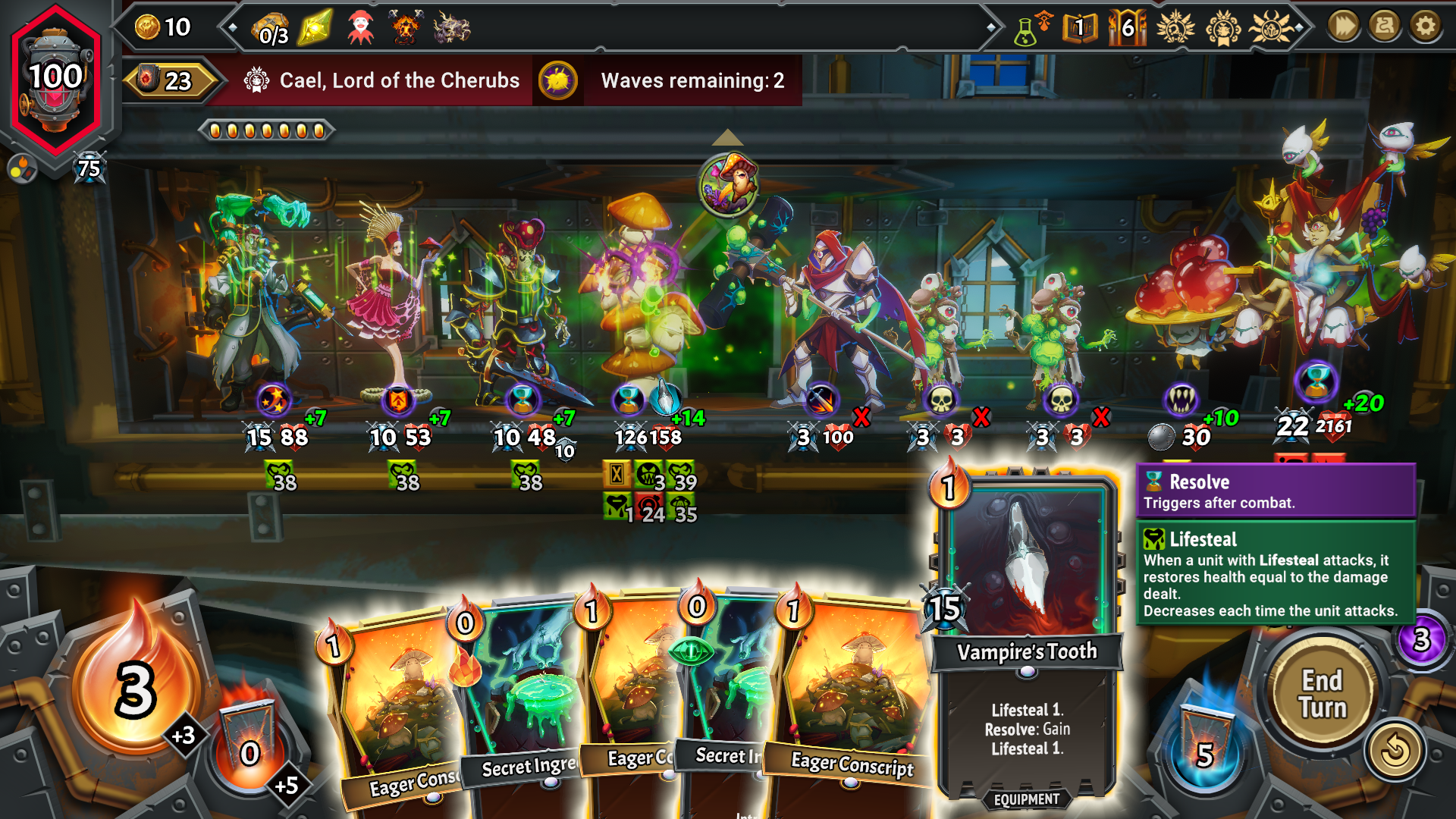
Among the many deck-building roguelikes, Monster Train stood out for the breadth of its tactical weirdness. Defending your train against waves of angels as you barrel through frozen hell, combining the unique strengths of factions brought with it immense variety, and unpredictable opportunities to make new strategies. The sequel builds on most of the strengths of its predecessor while bringing along only a few weaknesses, providing new story, challenge modes, clans, cards, enemies, and mechanics. There’s a lot to dig into, and the combination of these disparate tweaks makes for a more replayable game built on the same core engine.

That core, for newcomers, consists of a few elements, all of which have received nontrivial tweaks. You have a deck consisting of cards with units and spells. Your train has a Pyre with limited health, and you will travel through encounters with waves of enemies spawning in. The train has four levels with the Pyre at the top. Every turn, enemies will attack, receive attacks, and ascend to the next level. If they reach the top, they will damage your Pyre, threatening to end your run. Units have attack/health values and special abilities, and spells damage enemies, buff your units, or move units up or down levels or left/right to change attack order. Units and spells come from a few different Clans, each focussed around different elements or mechanics. You will also accumulate Artifacts, which permanently change the game in your favor by giving you ongoing benefits during a run.
Your run begins by choosing two Clans, receiving the base spells for each and one of the Clan’s Champions, a powerful unit with unique, often run-defining abilities. Each encounter includes a final boss to oppose your Champion. In the final wave, you will go back and forth until the boss or your team on a given floor is dead. New to the game are Room and Equipment cards. Room cards change the rules of a given level, like increasing magical potency or attack values. Equipment is placed on a unit to augment its stats and/or abilities. Between encounters, you will choose various paths to get new cards, upgrade your cards or champions, or proceed through special events for powerful risks or rewards.

Compared to the first game, Monster Train 2 has tons more content in all directions. New units, new types of basic Train Stewards based on attack or defense, new challenge modes, new events (which often include cameos from other indie games), ways to modify your engines and levels, and activated abilities on units with round-based cooldowns. I loved the prior game, but beyond the Covenant ascension, you got to the point where you mastered it and felt like you had seen everything. With the quantity of unlocks and additional modes, that point will take much longer to reach here. There are also small bits of flair added to the visual and sound design, though they remain substantially the same. There is a story now, giving you more context to the conflict and optional bits of humor as Clans interact with one another. Its portraiture with text lines is a far cry from inspired, but it’s a nice way to add to the game and keep you invested. It adds a lot of fun with those optional interactions, but it’s not enough to see you invested in the narrative. And hey, there's an undo button! If there was before, I didn't know about it.
Beyond the bevy of new content, Monster Train 2 amps up the challenge with many small tweaks to mechanics, and the amount of them that you’ll be balancing at a given time. Really, the little things add up. The game is more thoughtful about how it uses abilities, with more options to challenge your sense of strategy. I liked the first game, as a fun if mildly janky Slay the Spire inspiration, but this is a step beyond. You start out feeling less powerful, until you learn to chain seemingly weak benefits together.
As just a few examples from a Clan available in the demo, their base spell does 1 damage and inflicts Pyregal 1, which increases the damage an enemy receives by the stacks of Pyregal. On its own, this is pretty minimal, but careful application with other spells or accumulated against a boss will have an enormous impact. Another new mechanic, Dragon's Hoard, accumulates with different ability types and can be turned in for rewards after a battle, maxing out at 8 without special artifacts. They often take effort to earn even in small quantities. You must then ask yourself whether you want to spend them quickly for many smaller rewards or save them for fewer larger ones. It also tasks you to project your successes in the future and your ability to generate Hoard. There’s also a monster that gets a massive boost for every hoard you have, asking if you want to spend them at all. If you don’t you will end up wasting abilities by maintaining a max and never spending them.

The art has a lot of small details among the various Clans, and over time I observed many small details that brought them to life. Unfortunately, these are all too easy to miss. There’s so much going on mechanically and the camera is pulled back so far that you could easily skip over those details: the way the Train Stewards breathe, the changes to behaviors as others grow in size. One gains Spikes when it takes damage, and I noticed over time it slowly becoming more grotesque and engorged during the course of a battle. Moreover, the art style doesn’t have the kind of consistency to tell a striking story. There are plenty of inventive designs, but you could be forgiven for thinking this is a more basic mobile game until you get into the meat of the strategy, and pay more attention to the units.
While looking at the static unit placement, you can see which units will take how much damage by the end of the round. This updates while you consider playing a spell or using a cooldown ability. Despite that, and the mostly rewarding challenge you receive from all of your options, it can be too much to weigh at a given moment. Too many toggles, too many abilities, too many cards that you have no interest in because of how tight you'll need to play to do things correctly. If anything, it's too ambitious. The first game's design was always zany, its attractiveness in how broken you could be. Here, it's tuned a little too high. As much as there are opportunities to strategize and capitalize, at the end of the day there are sometimes too many special abilities and symbols flying around to reach total coherence.

At least, that’s what I thought at first. When you hit the ~10 hour mark and find the right core of unlocks, the game unwinds before you and you start to see how everything fits together. There are many cards or abilities which look tame at first, until you see how they can be spun out into ludicrous power levels with the right combination or investment.
Once you see how much there is and how well the unlocks fit together, you see that this is a step above the first game, indeed of most comparable roguelikes. Getting Pyrehearts and new clans feeds right into the challenge modes, pushing you to learn the mechanics better and push yourself farther. It’s a vision, at least for Slay the Spire addicts like me. Finally, a game that tries and rewards your abilities. All the while, that urge to make something broken is fed, giving the game appreciable longevity. I’m sitting at somewhere around 30 hours at time of writing, I have not unlocked everything, and I consider myself far from done. The interesting challenge trials on their own are great methods to change up the game and learn the nuances of some of the rare mechanics.

Because of the swings in power you can achieve, some of the latter bosses are absolutely nonsense in terms of difficulty. Even if you're using the many new tools at your disposal with a finely tuned deck and good maneuvers, you can get wiped out frustratingly fast. It's hard to tell how much of that is your underperformance and how much is the luck of the draw. As you unlock new abilities, that happens less often, but doesn’t stop completely. This is especially the case when you build your entire deck around a concept, then one monster’s special ability negates or punishes that concept. It doesn’t make you useless, but it isn’t as fun a challenge as you might suspect, and it could end your run. In this game, there isn’t the occasional option to make something broken but the ability to make it through with strong fundamentals. Either you finagle your way into a ridiculous series of combos or you lose.
While there are tons of unlocks that reward your time, the first 5-10 hours or so are a frustrating grind. Without access to the more interesting Clans or cards, you will have to spend a while beating your head against a wall and losing regardless of skill level. Based just on the demo or those first hours, you would have a false negative impression of how much greatness there is on offer in Monster Train 2.
It's also worth mentioning that I had a great experience on both the PC and Steam Deck. No technical issues with either, and the controls remained intuitive.
Monster Train 2
Great
While there’s sometimes too much going on under the hood, Monster Train 2 is more than a worthy successor to its sequel. With more options, more mechanics, more challenges, more story, and more customization, it’s a rare and rewarding challenge to fans of roguelike deck-builders that more than stands out against its competition, and an elevation from the prior game. It’s clear the designers gave this a comprehensive overhaul while retaining nearly all of the first game’s strengths.
Pros
- Tweaks small and large to make the experience rewarding
- Tons of new content in every direction
- Strategy with welcome challenge and variety
Cons
- Some of that challenge and variety can be overwhelming
- The art style is hard to read with cluttered interface
- The early game grind obscures its greatest strengths
This review is based on a retail PC copy provided by the publisher.
